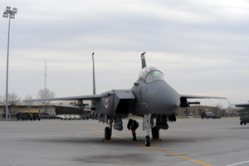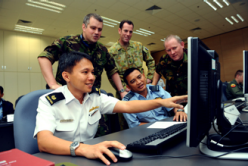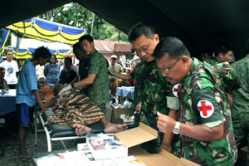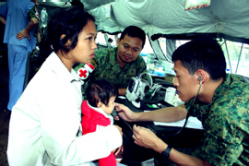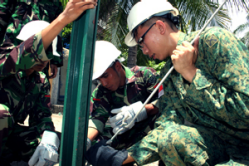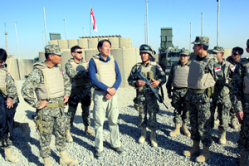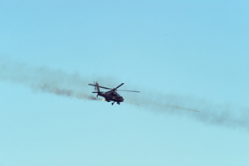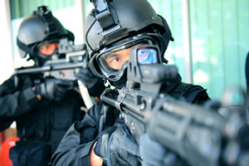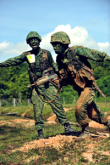OPS & TRAINING
A NETWORKED DEFENCE
05 Mar 2010
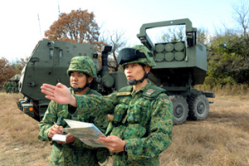
From diplomacy to deterrence, PIONEER takes a look at the Singapore Armed Forces' (SAF's) recent efforts in contributing to international security, and building a committed and network-enabled fighting force.
Events happening in another part of the world may sometimes seem far removed to the man on the street. However, with the emergence of transnational challenges such as terrorism, maritime security, natural disasters and the global economic crisis, it has become increasingly clear that these complex security concerns have the potential to affect peace and stability worldwide.
In the light of today's evolving security environment, where threats are often multi-faceted and cross-border in nature, the SAF has steadily strengthened its defence networks, both internally and externally, to effectively tackle this diverse set of challenges.
This network covers the SAF's interconnected system of sophisticated equipment and platforms, the integrated, multi-agency approach that it adopts in operations and the web of strong defence ties it has developed with other armed forces in the region and beyond.
A regional defence
Even though the global economy is beginning to show signs of picking up, uncertainties remain as the centre of global strategic and economic weight shifts to the Asia-Pacific, and as competition between major powers - both current and emerging - rises.
This widening spectrum of strategic interests, which includes trade interests and energy and resource needs, means that broad-based participation in dialogue and cooperation by an open and inclusive international community is more critical than ever in helping to build trust and bring about progress and development.
To that end, security frameworks like the Shangri-La Dialogue (SLD) and the ASEAN Defence Ministers' Meeting (ADMM), serve as useful platforms to identify and address common security challenges, as well as to promote mutual understanding and linkages among the regional and international communities.
As Deputy Prime Minister and Minister for Defence Teo Chee Hean pointed out in his remarks at the eighth SLD on 31 May 09: "When we better understand the concerns that we might have about each other, we can more confidently find ways to take these concerns into account and reassure each other. Where we have common concerns, we can find ways to cooperate meaningfully.
"This (the SLD) serves as an invaluable avenue for clarifying one's intentions, adjusting one's actions, and accommodating differences in perspective."
Last year, the ADMM, for instance, made further progress in the direction of practical cooperation with the signing of a Joint Declaration to strengthen ASEAN defence establishments' capacity to address non-traditional security threats.
Besides engaging in multilateral forums, the SAF has continued to deepen its relationships with other defence establishments through a broad range of activities, which include military exercises and
collaborative initiatives such as the Malacca Strait Patrols and the Five Power Defence Arrangements. In the wake of a devastating earthquake that hit West Sumatra, Indonesia, in late 2009, medical and engineering teams from the SAF were quickly deployed to provide medical help to quake victims and to aid in reconstruction efforts.
The SAF's medical and engineering teams provided swift aid to the people in the towns of Padang and Pariaman, Indonesia, when West Sumatra was hit by a devastating earthquake last year.
Singapore's long-standing defence relations with the United States were also given a boost with the inauguration of two new training detachments last year. The Peace Triton detachment comprises crew members of the Sikorsky S-70B Seahawk naval helicopter who have been training in San Diego, California, since November 2007. The RSS Stalwart, a Formidable-class stealth frigate, joined them late last year to undergo integration training.
The other is the Republic of Singapore Air Force's (RSAF's) Peace Carvin (PC) V detachment, which is training on Singapore's latest fighter aircraft - the F-15SG - at Mountain Home Air Force Base, Idaho. It is the latest addition to three existing training detachments in the US, which are for the F-16 fighter jet, Chinook and Apache helicopters.
On the benefits of training in Mountain Home, PC V Detachment Commander Lieutenant Colonel Lim Chee Meng said: "Our pilots, Weapon Systems Officers and ground crew do possess the operational experience and capabilities needed to operate the F-15SG. However, through interactions with our US counterparts, we are able to further enhance and improve the quality of experience and skills we have."
Defence relations with China also took a step forward as the SAF and the People's Liberation Army embarked on their first bilateral training exercise in June 2009. This joint counter-terrorism exercise provided an opportunity to foster better understanding between the two armed forces.
An international role
While the SAF's series of deployments to Iraq may have concluded, peace support and international security initiatives continue to be an important part of its operations.
Maritime threats such as piracy have a negative impact on Singapore's economic well-being - because it is situated at the key global sea routes of the Straits of Malacca and Singapore - as well as regional stability and prosperity.
Although Singapore's seaward defence remains the Republic of Singapore Navy's (RSN) main focus, the growing threat of piracy in the Gulf of Aden is a source of international concern which demonstrates that contemporary security challenges can no longer be solved by a single country or a small exclusive group of countries acting on its own, stressed Mr Teo in his opening address at the International Maritime Defence Exhibition and Conference Asia on 12 May 09.
"The response to the situation in the Gulf of Aden requires a broader range of actors and stakeholders to be co-opted and engaged. Only then will we collectively have the capacity, resources, reach, ideas and expertise to deal with the problem," he added.
Following the success of the SAF's first deployment to the piracy hotspot in mid-2009, Rear-Admiral Bernard Miranda, supported by a command team, recently took over command of Combined Task Force 151 (CTF 151) on 20 Jan. CTF 151 is a multinational task force set up in January last year to conduct counter-piracy operations in the Gulf of Aden and the Somali Basin.
Just as maritime security remains a common challenge to all nations, terrorism is a persistent global problem which needs concerted multinational action to overcome. Since 2007, the SAF has supported the stabilisation and reconstruction efforts in Afghanistan, a country at the front line in the fight against terrorism.
In addition to a construction engineering team sent to the Bamiyan province in central Afghanistan, which supervised the construction of a paediatric and women's ward extension for the local hospital, a Weapon Locating Radar (WLR) team was deployed to a base in Tarin Kowt, the capital of Oruzgan province. The team comprised two 17-man rotations stretched over six months from September 2009 to June this year. The WLR helps to provide early warning of rocket attacks and enhanced force protection for International Security Assistance Force personnel at the base.
A medical team was also recently sent to provide emergency and trauma care as well as primary health care at a field hospital in Oruzgan from end-2009 to March this year.
An advanced arsenal
Despite heavier demands as the SAF becomes increasingly involved in international security operations, the security of Singapores air, sea and land remains its top priority.
Banking on the strengths of a networked-enabled force, the SAF has consistently invested in the acquisition and development of new capabilities and technologies which create a significant force-multiplier effect when combined.
For instance, the range and reach of the RSN's Formidable-class stealth frigates, which replaced the navys fleet of long-serving Missile Gunboats, will be further extended with the upcoming integration of the Sikorsky naval helicopters. Boasting an indigenously developed Combat Management System that is connected to the SAF's Integrated Knowledge-based Command and Control network, these frigates act as key nodes capable of coordinating sister ships and aerial assets.
"As part of this network, we are able to tap the information and sensor status from the whole SAF, as well as provide information from our own sensors to contribute to the wider SAF operational and tactical picture," explained Colonel Giam Hock Koon, Commanding Officer of 185 Squadron which comprises the six frigates and had achieved full operational capability in early 2009.
Similarly, the Army's new Terrex Infantry Carrier Vehicles can increase collective situational awareness for troops by connecting with other air and land assets via the Battlefield Management System (BMS) and Advanced Combat Man System. With a clearer picture of the operating environment and timely battlefield information provided by the BMS, soldiers can call for support from air and land forces to coordinate manoeuvres and deliver precision fire on enemy targets.
The effectiveness of such networked fighting concepts was validated and brought to new heights during Exercise Forging Sabre 2009, the biggest and most complex live-firing and air-land integrated strike exercise which the SAF has conducted to date.
Tight synchronisation between the Division Strike Centre and Air-Land Tactical Control Centre helped to achieve greater operational synergy between numerous air and land elements in orchestrating an integrated strike against simulated enemy targets.
Gathering data from a wide variety of available sensors - such as Unmanned Aerial Vehicles and specially-trained Commando teams - these networked command centres allow for more accurate and faster decision-making in delivering appropriate and precise fire power from various shooters, which include F-16 fighters, Apache helicopters and field artillery like the High Mobility Artillery Rocket System.
Noting that the SAF has been sharpening these capabilities constantly through regular air-land integration exercises such as Lightning Warrior and Wallaby, Forging Sabre Exercise Director Brigadier-General Tan Chuan-Jin said: "Exercises like Forging Sabre are vital in building up the capabilities of the 3rd Generation SAF because they allow the Army and Air Force to practise working together and to hone their communication skills."
A ready and integrated force
To ensure smooth information-sharing and tighter coordination among national agencies in homeland security operations, the SAF has also set up new command structures which can harness capabilities from across the Services to deal with any threat.
Just as the RSAF completed a major transformation and organisational restructuring in recent years, the RSN's Coastal Command underwent a revamp to form the Maritime Security Task Force (MSTF) early last year.
Complementing the Island Defence Task Force and Air Defence Operations Command, the MSTF functions as an integral part of the SAF's comprehensive security measures. Not only is the MSTF able to call upon assets beyond the Navy, it collaborates closely with key national maritime agencies like the Police Coast Guard and the Maritime Port Authority to provide round-the-clock protection of Singapore's waters.
Through the Special Operations Task Force (SOTF), which brings special forces from the Army, Navy and other SAF combat forces under one central command, the SAF can swiftly coordinate elite troops with highly-specialised skills and customise its response in special operations, counter-terrorism operations and contingency operations.
"With the SOTF...we are better able to handle any kind of security threat or incident that could harm homeland security," said Colonel Lam Shiu Tong, Commander SOTF and Chief Commando Officer.
Reflecting the SAF's cross-Service, multi-agency approach in operations, the SOTF displayed their capabilities in a combined show of force together with 14 other homeland agencies during 2009's Exercise Northstar VII an annual counter-terrorism drill.
A capable and committed core
Sophisticated hardware and training exercises aside, the heart of Singapore's defence network lies in the human element.
As the driving force in its transformation journey, several human resource initiatives were launched last year to match the diverse aspirations of servicemen with the new organisational needs of the 3rd Generation SAF.
With enhanced career schemes for officers and warrant officers, as well as a new career track called the Military Domain Experts Scheme (MDES), both existing personnel as well as potential recruits can look forward to more choices and chances for academic upgrading and professional development. To date, 95 percent of current personnel who were offered MDES, have accepted the offer to convert to the new scheme.
In an interview with PIONEER, Chief of Defence Force Lieutenant-General Desmond Kuek said that "these enhancements will allow greater differentiation in career development and deployment opportunities for our people in service, and appeal to a new generation of Singaporeans joining the SAF.
"They will also position the SAF to better meet the more environmentally complex, technologically-advanced and integrated force demands of today and in the future."
These efforts in people development were also complemented by a number of changes to the Basic Military Training (BMT) system, which include revised programmes that range from four to 19 weeks according to the individual's fitness level and medical classification.
Customised to suit the medical conditions of recruits, these new BMT programmes aim to not only continue training combat-ready soldiers in a safe and effective manner, but also instil a greater sense of purpose towards defence and to better prepare them for their eventual roles within the SAF.
Recognising that its people - both Regulars and National Servicemen - function as the vital core of Singapore's defence network, the SAF has made continual improvements in the training, nurturing and engagement of its men and women.
A collective effort
As the security landscape continues to evolve with an expanding range of multi-dimensional challenges, the SAF strives to adapt and keep pace through its transformation into an effective and networked fighting force.
This tightly-woven web of connections, which includes the integration of hi-tech hardware and systems, Services and multiple agencies, the strong ties between countries and the bonds forged among servicemen, is what keeps the SAF ever ready to meet any challenge and to ensure the continued peace and security of Singapore.
ALSO READ IN OPS & TRAINING

Exercise Wallaby 2025: To see better, shoot faster
31 Oct 2025
The SAF focuses on complex strike missions and multi-domain integration in Exercise Wallaby 2025, the 35th edition of its largest unilateral overseas exercise.

Ex Wallaby 25 – Greater Integration and Complexity
25 Oct 2025
The 35th edition of the SAF’s largest unilateral overseas exercise is an opportunity for expanded scale and deeper integration towards an effective, networked fighting force.

Ex Forging Sabre ramps up use of unmanned assets in integrated strike operations
12 Sep 2025
In this 10th edition of Exercise Forging Sabre, the SAF sharpened its cutting edge for the dynamic modern battlefield, with expanded integration between manned and unmanned platforms.


